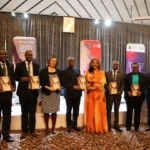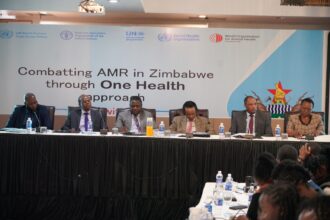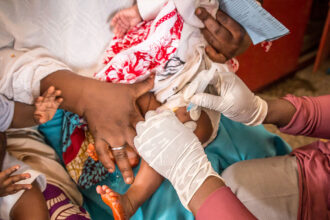By Conrad Mwanawashe
I had a conversation with a long-time lady friend after a very long time.
Normally one would expect such reconnection conversations to be full of memories, laughter and happiness.
Ours ended up depressing.
Tendai (not her real name) was in tears. She and her husband had planned to have five kids but they were forced to be content with only two.
“Why can you not grow the family,” I asked.
“We can’t afford the cost of diapers and general children’s upkeep,” she said wiping off tears.
“I know I have three more babies in me, maybe more, but we agreed that we cannot bring children into the world to suffer. We can’t afford the cost of having babies. We are actually struggling to provide for the two we have. The cost of living is too high, so we’ve accepted it,” Tendai said.
Little did I know that her troubles are not an isolated case.
Friday, 11 July, the United Nations Population Fund (UNFPA) released a report which highlights this silent global challenge.
UNFPA’s 2025 State of World Population (SWOP) report titled: The Real Fertility Crisis: The pursuit of reproductive agency in a changing world says that there are millions of people, like Tendai, who are being stopped from having the number of children they want because of economic and social barriers.
 The SWOP report, which was launched together with government and partners showed a significant decline in fertility rates globally, especially among young people.
The SWOP report, which was launched together with government and partners showed a significant decline in fertility rates globally, especially among young people.
The report reveals that 1 in 5 people globally expect not to have the number of children they desire due to barriers such as high cost of parenthood and health care, job insecurity and the lack of a suitable partner. More than half of 10,000 survey respondents said economic issues were a factor in having fewer children than wanted.
These findings mirror the situation in Zimbabwe where couples, especially in urban areas are reducing the sizes of their families.
Total Fertility Rate (TFR) – the average number of children a woman would have by the end of her childbearing years if she bore children at the current age-specific fertility rates – dropped 4.3 children per woman in 1994 to 3.8 in 2005-06. Since then, it has remained largely stable, currently standing at 3.9 in the 2023-24 Zimbabwe Demographic and Health Survey.
On average, a woman in Zimbabwe will have about 4 children in her lifetime (TRF 3.9). When disaggregated by place of birth women in rural areas (about 5 children per woman – TFT 4,6 tend to have more children than those in urban areas (about 3 children per woman – TFR 3.1). Women in urban areas begin childbearing 2 years later, on average, than rural women (21.1 versus 19.4 years).
In Zimbabwe, fertility rates decrease as household wealth increases. Women in the lowest wealth quintile have significantly more children (5.5) compared to those in the highest quintile (2.6). Women in the lowest wealth quintile have their first birth, on average, 3 years earlier (19.0 years) than women in the highest quintile (21.9 years).
Health and Child Care, Dr Douglas Mombeshora said government upholds reproductive rights, empowering individuals to choose the number, timing, and spacing of children they want to have, free from coercion.
“Fertility rates are a key driver of Zimbabwe’s continued population growth and contribute significantly to its youthful demographic structure. We will continue to support policies to ensure we prevent low birth rates,” Dr Mombeshora said.
UNFPA Executive Director Dr Natalia Kanem, said vast numbers of people are unable to create the families they want.
“The issue is lack of choice, not desire, with major consequences for individuals and societies. That is the real fertility crisis, and the answer lies in responding to what people say they need: paid family leave, affordable fertility care, and supportive partners,” Dr Kanem said.
Even if women, especially those in the workplace, desire to have more children, childcare responsibilities often make it difficult for them to pursue career advancement, maintain full-time employment or engage in professional development opportunities. This in part explains why women in the highest wealth quintile have less children.
According to the report, gender inequality deepens the crisis. Gender inequality, unpaid caregiving, and unequal domestic roles are silent drivers of underachieved fertility goals. Women still do 3 to 10 times more unpaid domestic and childcare work than men. At least 14% of survey respondents said they won’t have the number of children they want because they lack a partner or lack a suitable partner.
UK Development Director and Deputy Head of Mission Dr Jo Abbot said the report is a wake-up call.
“When people are unable to have the families they want due to economic or social barriers, it’s not just a personal loss – it’s a development challenge. We are committed to supporting policies and partnerships that empower individuals, especially women and young people, to make informed, free choices about their futures,” said Dr Abbot.
UNFPA urges governments to empower people to make informed reproductive decisions freely, including by investing in affordable housing, decent work, parental leave and the full range of reproductive health services and reliable information.
“This report underscores a critical truth: the ability to choose the size and timing of one’s family is a fundamental human right. When economic precarity, gender inequality, and societal pressures limit these choices, we face a ‘real fertility crisis,” said UNFPA Country Representative Ms. Miranda Tabifor.
“UNFPA is committed to working with all partners to ensure that every individual has the resources and support needed to realize their reproductive aspirations, fostering societies where rights and choices are universal.”
About the State of World Population Report
The State of World Population report is UNFPA’s annual flagship publication. Published yearly since 1978, it shines a light on emerging issues in the field of sexual and reproductive health and rights, bringing them into the mainstream and exploring the challenges and opportunities they present for international development.












